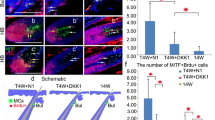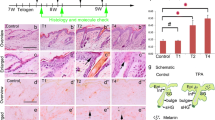Abstract
Regeneration of hair follicles relies on activation of hair follicle stem cells during telogen to anagen transition process in hair cycle. This process is rigorously controlled by intrinsic and environmental factors. 12-o-tetradecanoylphorbol-13-acetate (TPA), a tumor promoter, accelerates reentry of hair follicles into anagen phase. However, it is unclear that how TPA promotes the hair regeneration. In the present study, we topically applied TPA onto the dorsal skin of 2-month-old C57BL/6 female mice to examine the activity of hair follicle stem cells and alteration of signaling pathways during hair regeneration. We found that refractory telogen hair follicles entered anagen prematurely after TPA treatment, with the enhanced proliferation of CD34-positive hair follicle stem cells. Meanwhile, we observed Akt signaling was activated in epidermis, hair infundibulum, bulge and hair bulb, and Wnt signaling was also activated after hair follicle stem cells proliferation. Importantly, after overexpression of DKK1, a specific Wnt signaling inhibitor, the accelerated reentry of hair follicles into anagen induced by TPA was abolished. Our data indicated that TPA-induced hair follicle regeneration is associated with activation of Akt and Wnt/β-catenin signaling.






Similar content being viewed by others
Abbreviations
- H&E:
-
Hematoxylin and eosin staining
- ORS:
-
Outer root sheath
- RT-PCR:
-
Reverse transcription-polymerase chain reaction
- TPA:
-
12-o-Tetradecanoylphorbol-13-acetate
References
Abel EL, Angel JM, Kiguchi K, DiGiovanni J (2009) Multi-stage chemical carcinogenesis in mouse skin: fundamentals and applications. Nat Protoc 4(9):1350–1362. doi:10.1038/nprot.2009.120
Andl T, Reddy ST, Gaddapara T, Millar SE (2002) WNT signals are required for the initiation of hair follicle development. Dev Cell 2(5):643–653
Bai X, Lei M, Shi J, Yu Y, Qiu W, Lai X, Liu Y, Yang T, Yang L, Widelitz RB, Chuong CM, Lian X (2015) Roles of GasderminA3 in catagen-telogen transition during hair cycling. J Invest Dermatol 135(9):2162–2172. doi:10.1038/jid.2015.147
Blanpain C, Lowry WE, Geoghegan A, Polak L, Fuchs E (2004) Self-renewal, multipotency, and the existence of two cell populations within an epithelial stem cell niche. Cell 118(5):635–648. doi:10.1016/j.cell.2004.08.012
Braun KM, Niemann C, Jensen UB, Sundberg JP, Silva-Vargas V, Watt FM (2003) Manipulation of stem cell proliferation and lineage commitment: visualisation of label-retaining cells in wholemounts of mouse epidermis. Development 130(21):5241–5255. doi:10.1242/dev.00703
Chen RH, Ding WV, McCormick F (2000) Wnt signaling to beta-catenin involves two interactive components. Glycogen synthase kinase-3beta inhibition and activation of protein kinase C. J Biol Chem 275(23):17894–17899. doi:10.1074/jbc.M905336199
Collins CA, Kretzschmar K, Watt FM (2011) Reprogramming adult dermis to a neonatal state through epidermal activation of beta-catenin. Development 138(23):5189–5199. doi:10.1242/dev.064592
Cotsarelis G, Sun TT, Lavker RM (1990) Label-retaining cells reside in the bulge area of pilosebaceous unit: implications for follicular stem cells, hair cycle, and skin carcinogenesis. Cell 61(7):1329–1337
DasGupta R, Fuchs E (1999) Multiple roles for activated LEF/TCF transcription complexes during hair follicle development and differentiation. Development 126(20):4557–4568
Fuchs E, Raghavan S (2002) Getting under the skin of epidermal morphogenesis. Nat Rev Genet 3(3):199–209. doi:10.1038/nrg758
Greco V, Chen T, Rendl M, Schober M, Pasolli HA, Stokes N, Dela Cruz-Racelis J, Fuchs E (2009) A two-step mechanism for stem cell activation during hair regeneration. Cell Stem Cell 4(2):155–169. doi:10.1016/j.stem.2008.12.009
Hsu YC, Pasolli HA, Fuchs E (2011) Dynamics between stem cells, niche, and progeny in the hair follicle. Cell 144(1):92–105. doi:10.1016/j.cell.2010.11.049
Huelsken J, Vogel R, Erdmann B, Cotsarelis G, Birchmeier W (2001) beta-Catenin controls hair follicle morphogenesis and stem cell differentiation in the skin. Cell 105(4):533–545
Ito M, Liu Y, Yang Z, Nguyen J, Liang F, Morris RJ, Cotsarelis G (2005) Stem cells in the hair follicle bulge contribute to wound repair but not to homeostasis of the epidermis. Nat Med 11(12):1351–1354. doi:10.1038/nm1328
Kimura-Ueki M, Oda Y, Oki J, Komi-Kuramochi A, Honda E, Asada M, Suzuki M, Imamura T (2012) Hair cycle resting phase is regulated by cyclic epithelial FGF18 signaling. J Invest Dermatol 132(5):1338–1345. doi:10.1038/jid.2011.490
Lei M, Chuong CM (2016) STEM CELLS. Aging, alopecia, and stem cells. Science 351(6273):559–560. doi:10.1126/science.aaf1635
Lei M, Gao X, Yang L, Yang T, Lian X (2011) Gsdma3 gene is needed for the induction of apoptosis-driven catagen during mouse hair follicle cycle. Histochem Cell Biol 136(3):335–343. doi:10.1007/s00418-011-0845-8
Lei M, Bai X, Yang T, Lai X, Qiu W, Yang L, Lian X (2012) Gsdma3 is a new factor needed for TNF-alpha-mediated apoptosis signal pathway in mouse skin keratinocytes. Histochem Cell Biol 138(3):385–396. doi:10.1007/s00418-012-0960-1
Lei M, Yang T, Lai X, Bai X, Qiu W, Lian X, Yang L (2013a) Upregulation of interfollicular epidermal and hair infundibulum beta-catenin expression in Gsdma3 mutant mice. Acta Histochem 115(1):63–69. doi:10.1016/j.acthis.2012.04.002
Lei MX, Chuong CM, Widelitz RB (2013b) Tuning Wnt signals for more or fewer hairs. J Invest Dermatol 133(1):7–9. doi:10.1038/jid.2012.446
Lei M, Guo H, Qiu W, Lai X, Yang T, Widelitz RB, Chuong CM, Lian X, Yang L (2014) Modulating hair follicle size with Wnt10b/DKK1 during hair regeneration. Exp Dermatol 23(6):407–413. doi:10.1111/exd.12416
Lei M, Lai X, Bai X, Qiu W, Yang T, Liao X, Chuong CM, Yang L, Lian X, Zhong JL (2015) Prolonged overexpression of Wnt10b induces epidermal keratinocyte transformation through activating EGF pathway. Histochem Cell Biol 144(3):209–221. doi:10.1007/s00418-015-1330-6
Li YH, Zhang K, Yang K, Ye JX, Xing YZ, Guo HY, Deng F, Lian XH, Yang T (2013) Adenovirus-MEDIATED Wnt10b overexpression induces hair follicle regeneration. J Invest Dermatol 133:42–48. doi:10.1038/jid.2012.235
Lin HY, Kao CH, Lin KM, Kaartinen V, Yang LT (2011) Notch signaling regulates late-stage epidermal differentiation and maintains postnatal hair cycle homeostasis. PLoS One 6(1):e15842. doi:10.1371/journal.pone.0015842
Lu J, Rho O, Wilker E, Beltran L, Digiovanni J (2007) Activation of epidermal akt by diverse mouse skin tumor promoters. Mol Cancer Res 5(12):1342–1352. doi:10.1158/1541-7786.MCR-07-0115
Murayama K, Kimura T, Tarutani M, Tomooka M, Hayashi R, Okabe M, Nishida K, Itami S, Katayama I, Nakano T (2007) Akt activation induces epidermal hyperplasia and proliferation of epidermal progenitors. Oncogene 26(33):4882–4888
Oshimori N, Fuchs E (2012) Paracrine TGF-beta signaling counterbalances BMP-mediated repression in hair follicle stem cell activation. Cell Stem Cell 10(1):63–75. doi:10.1016/j.stem.2011.11.005
Paus R, Muller-Rover S, Van Der Veen C, Maurer M, Eichmuller S, Ling G, Hofmann U, Foitzik K, Mecklenburg L, Handjiski B (1999) A comprehensive guide for the recognition and classification of distinct stages of hair follicle morphogenesis. J Invest Dermatol 113(4):523–532. doi:10.1046/j.1523-1747.1999.00740.x
Qiu W, Yang K, Lei M, Yan H, Tang H, Bai X, Yang G, Lian X, Wu J (2015) SCF/c-kit signaling is required in 12-O-tetradecanoylphorbol-13-acetate-induced migration and differentiation of hair follicle melanocytes for epidermal pigmentation. Cell Tissue Res 360(2):333–346. doi:10.1007/s00441-014-2101-8
Qiu W, Tang H, Guo H, Lei M, Yan H, Lian X, Wu J (2016) 12-O-tetradecanoylphorbol-13-acetate activates hair follicle melanocytes for hair pigmentation via Wnt/beta-catenin signaling. Cell Tissue Res 366(2):329–340. doi:10.1007/s00441-016-2450-6
Rabbani P, Takeo M, Chou W, Myung P, Bosenberg M, Chin L, Taketo MM, Ito M (2011) Coordinated activation of Wnt in epithelial and melanocyte stem cells initiates pigmented hair regeneration. Cell 145(6):941–955. doi:10.1016/j.cell.2011.05.004
Reddy S, Andl T, Bagasra A, Lu MM, Epstein DJ, Morrisey EE, Millar SE (2001) Characterization of Wnt gene expression in developing and postnatal hair follicles and identification of Wnt5a as a target of Sonic hedgehog in hair follicle morphogenesis. Mech Dev 107(1–2):69–82
Segrelles C, García-Escudero R, Garín MI, Aranda JF, Hernández P, Ariza JM, Santos M, Paramio JM, Lorz C (2014) Akt signaling leads to stem cell activation and promotes tumor development in epidermis. Stem Cells 32(7):1917–1928. doi:10.1002/stem.1669
Sun W, Lee H, Choe Y, Cho S, Kim DH, Kim K (2001) Evidence for direct involvement of beta-catenin in phorbol ester-induced neurite outgrowth in GT1-1 hypothalamic neurones. J Neuroendocrinol 13(3):249–260
Suzuki K, Yamaguchi Y, Villacorte M, Mihara K, Akiyama M, Shimizu H, Taketo MM, Nakagata N, Tsukiyama T, Yamaguchi TP, Birchmeier W, Kato S, Yamada G (2009) Embryonic hair follicle fate change by augmented beta-catenin through Shh and Bmp signaling. Development 136(3):367–372. doi:10.1242/dev.021295
Trempus CS, Morris RJ, Bortner CD, Cotsarelis G, Faircloth RS, Reece JM, Tennant RW (2003) Enrichment for living murine keratinocytes from the hair follicle bulge with the cell surface marker CD34. J Invest Dermatol 120(4):501–511. doi:10.1046/j.1523-1747.2003.12088.x
Trempus CS, Morris RJ, Ehinger M, Elmore A, Bortner CD, Ito M, Cotsarelis G, Nijhof JG, Peckham J, Flagler N, Kissling G, Humble MM, King LC, Adams LD, Desai D, Amin S, Tennant RW (2007) CD34 expression by hair follicle stem cells is required for skin tumor development in mice. Cancer Res 67(9):4173–4181. doi:10.1158/0008-5472.CAN-06-3128
Van Mater D, Kolligs FT, Dlugosz AA, Fearon ER (2003) Transient activation of beta -catenin signaling in cutaneous keratinocytes is sufficient to trigger the active growth phase of the hair cycle in mice. Genes Dev 17(10):1219–1224. doi:10.1101/gad.1076103
Zhang J, He XC, Tong WG, Johnson T, Wiedemann LM, Mishina Y, Feng JQ, Li L (2006) Bone morphogenetic protein signaling inhibits hair follicle anagen induction by restricting epithelial stem/progenitor cell activation and expansion. Stem Cells 24(12):2826–2839. doi:10.1634/stemcells.2005-0544
Zheng X, Ravatn R, Lin Y, Shih WC, Rabson A, Strair R, Huberman E, Conney A, Chin KV (2002) Gene expression of TPA induced differentiation in HL-60 cells by DNA microarray analysis. Nucleic Acids Res 30(20):4489–4499
Acknowledgements
This study was supported by the National Nature Science Foundation of China (30972645 and 81602782), and Natural Science Foundation of Hubei Province (2016CFB348). Mingxing Lei is supported by Project funded by China Postdoctoral Science Foundation (2016M590866), Fundamental Research Funds for the Central Universities (106112015CDJRC231206), Special Funding for Postdoctoral Research Projects in Chongqing (Xm2015093), and a fellowship from the China Scholarship Council (2011605042).
Author information
Authors and Affiliations
Corresponding author
Ethics declarations
Conflict of interest
The authors declare no conflict of interest.
Electronic supplementary material
Below is the link to the electronic supplementary material.
Rights and permissions
About this article
Cite this article
Qiu, W., Lei, M., Zhou, L. et al. Hair follicle stem cell proliferation, Akt and Wnt signaling activation in TPA-induced hair regeneration. Histochem Cell Biol 147, 749–758 (2017). https://doi.org/10.1007/s00418-017-1540-1
Accepted:
Published:
Issue Date:
DOI: https://doi.org/10.1007/s00418-017-1540-1




